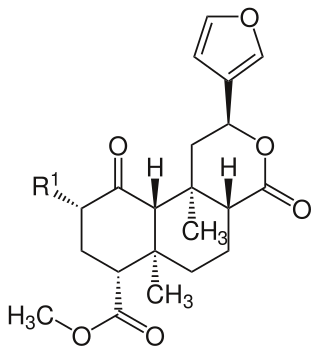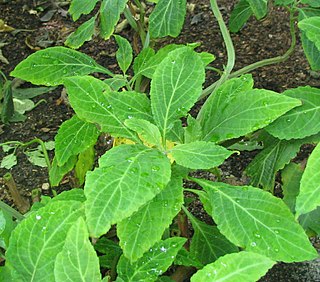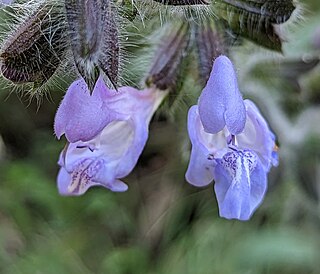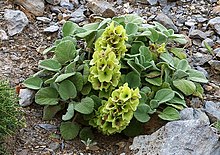
Kumquats, or cumquats in Australian English, are a group of small, angiosperm, fruit-bearing trees in the family Rutaceae. Their taxonomy is disputed. They were previously classified as forming the now-historical genus Fortunella or placed within Citrus, sensu lato. Different classifications have alternatively assigned them to anywhere from a single species, Citrus japonica, to numerous species representing each cultivar. Recent genomic analysis defines three pure species, Citrus hindsii, C. margarita and C. crassifolia, with C. × japonica being a hybrid of the last two.

Salvinorin A is the main active psychotropic molecule in Salvia divinorum. Salvinorin A is considered a dissociative hallucinogen.

Psilocybin mushrooms, commonly known as magic mushrooms or shrooms, are a polyphyletic informal group of fungi that contain psilocybin, which turns into psilocin upon ingestion. Biological genera containing psilocybin mushrooms include Psilocybe, Panaeolus, Inocybe, Pluteus, Gymnopilus, and Pholiotina.

Psilocybe is a genus of gilled mushrooms, growing worldwide, in the family Hymenogastraceae. Many species contain the psychedelic compounds psilocybin and psilocin.

Salvinorins are a group of natural chemical compounds and their structural analogs. Several salvinorins have been isolated from Salvia divinorum. They are classified as diterpenoid furanolactones. Salvinorin A is a hallucinogen with dissociative effects.

Calea ternifolia is a species of flowering plant in the aster family, Asteraceae. It is native to Mexico and Central America. Its English language common names include bitter-grass, Mexican calea, and dream herb.

Salvia glutinosa, the glutinous sage, sticky sage, Jupiter's sage, or Jupiter's distaff, is a herbaceous perennial plant belonging to the family Lamiaceae.
An oneirogen, from the Greek ὄνειρος óneiros meaning "dream" and gen "to create", is a substance or other stimulus which produces or enhances dreamlike states of consciousness. This is characterized by an immersive dream state similar to REM sleep, which can range from realistic to alien or abstract.

The ancient Aztecs employed a variety of entheogenic plants and animals within their society. The various species have been identified through their depiction on murals, vases, and other objects.

Jonathan Ott is an ethnobotanist, writer, translator, publisher, natural products chemist and botanical researcher in the area of entheogens and their cultural and historical uses, and helped coin the term "entheogen".

Salvia miltiorrhiza, also known as red sage, redroot sage, Chinese sage, or danshen, is a perennial plant in the genus Salvia, highly valued for its roots in traditional Chinese medicine. Native to China and Japan, it grows at 90 to 1,200 m elevation, preferring grassy places in forests, hillsides, and along stream banks. The specific epithet miltiorrhiza means "red ochre root".
Signed into law June 28, 2005, and effective August 8, 2005, Louisiana State Act No 159 found in, Louisiana RS 40:989.1, outlawed the cultivation, possession or sale of 40 named plants defined as hallucinogenic in the state of Louisiana, US. House Bill 173 of 2010 further restricted the sale and possession of herbs in the state. However, use of the plants "strictly for aesthetic, landscaping, or decorative purposes" was allowed. The list contained as many as thirty legitimate herbs of commerce which had no hallucinogenic properties. The law was amended in 2015 to allow certain herbs that had been banned by the state to again be sold in dietary supplement products.

The Cleomaceae are a small family of flowering plants in the order Brassicales, comprising about 220 species in two genera, Cleome and Cleomella. These genera were previously included in the family Capparaceae, but were raised to a distinct family when DNA evidence suggested the genera included in it are more closely related to the Brassicaceae than they are to the Capparaceae. The APG II system allows for Cleomaceae to be included in Brassicaceae. Cleomaceae includes C3, C3–C4, and C4 photosynthesis species.

Salvia divinorum is a plant species with transient psychoactive properties when its leaves, or extracts made from the leaves, are administered by smoking, chewing, or drinking. The leaves contain the potent compound salvinorin A and can induce a dissociative state and hallucinations.

Salvia is the largest genus of plants in the sage family Lamiaceae, with nearly 1000 species of shrubs, herbaceous perennials, and annuals. Within the Lamiaceae, Salvia is part of the tribe Mentheae within the subfamily Nepetoideae. One of several genera commonly referred to as sage, it includes two widely used herbs, Salvia officinalis and Salvia rosmarinus.

Salvia recognita is a woody-based perennial that is endemic to central Turkey, typically growing in light shade at the base of cliffs, at elevations of less than 4,000 feet (1,200 m). This species has been reported to contain salvinorin A. However, this report has not been replicated, and a previous study of 441 Salvia species from many regions found salvinorin A only in Salvia divinorum, from Mexico.
The legal status of Salvia divinorum in the United States varies, with 29 states having completely banned it and others considering proposals for banning its use.

Psychoactive plants are plants, or preparations thereof, that upon ingestion induce psychotropic effects. As stated in a reference work:
Psychoactive plants are plants that people ingest in the form of simple or complex preparations in order to affect the mind or alter the state of consciousness.

Myrtenal is a bicyclic monoterpenoid with the chemical formula C10H14O. It is a naturally occurring molecule that can be found in numerous plant species including Hyssopus officinalis, Salvia absconditiflora, and Cyperus articulatus.















